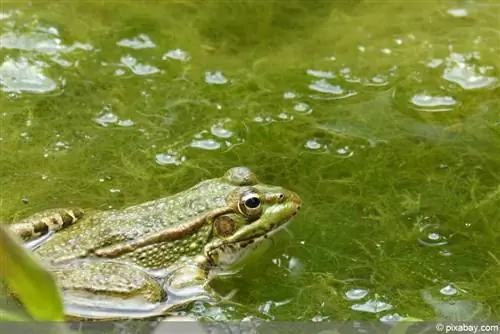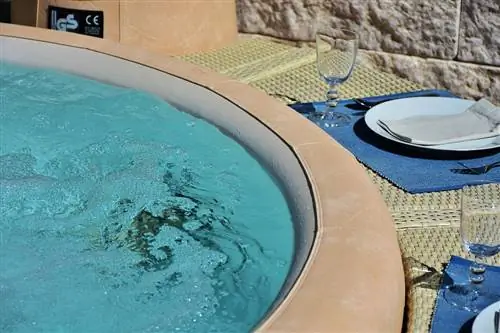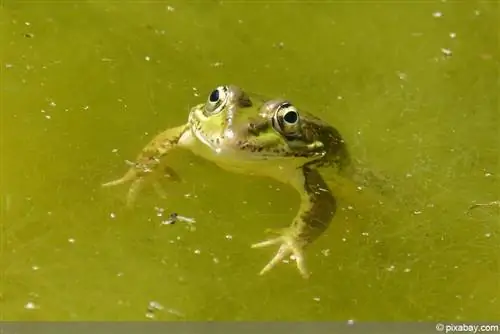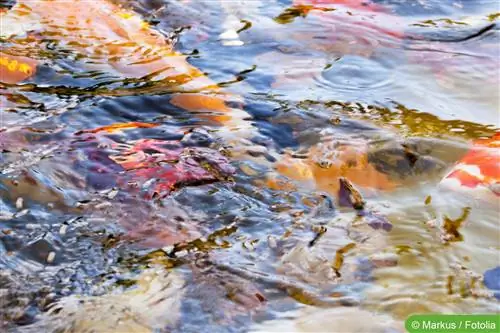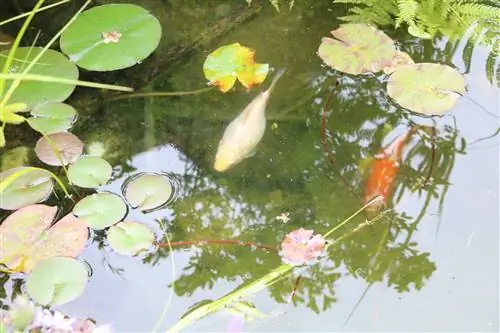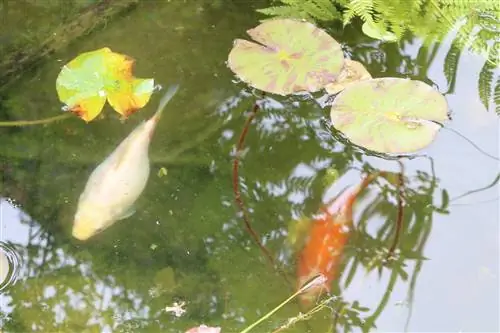- Author admin [email protected].
- Public 2023-12-17 03:39.
- Last modified 2025-01-24 12:45.
Green water in the garden pond is a warning sign that indicates an imbalance and the cause of which should be eliminated as quickly as possible. Otherwise, the water can “tip over” and the animals living in the pond, such as fish, frogs and mulches, are in danger. Anyone interested can find out here how cloudy pond water can be prevented and how it can be eliminated.
Causes
In order to successfully eliminate cloudy or green water in the garden pond, the trigger must first be known. There are basically four possible causes for cloudy pond water:
- Refill or partial water change
- Pollution caused by mulm
- Bacteria
- Algae
System and partial water change
If a pond is refilled or a partial water change is carried out, soil or dirt can be stirred up or dyes can be washed out of decorative elements and gravel. The water then appears milky to yellow, gray or brown. If a completely new pond is created, the water first has to run in and looks milky for several days to a few weeks. Once a he althy balance has been established, the pond water clears.
Tip:
This process can be accelerated with special water conditioners and the use of a filter.
Pollution
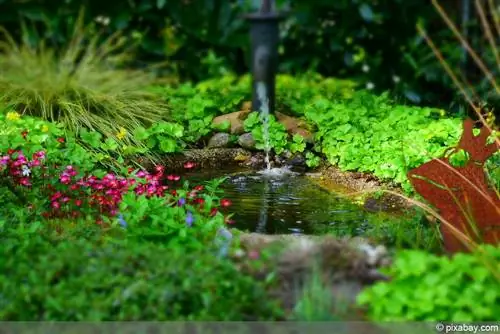
Over time, a layer of sludge settles at the bottom of the garden pond. It consists, among other things, of:
- Leftover food
- Fish or animal droppings
- Dividing plants
- Registered contamination
So it is organic material that is decomposed by the bacteria in the water. If the sludge is stirred up, for example because fish are bubbling on the bottom, it acts like a kind of cloud of mud in the water and temporarily clouds it. If the sludge settles down again, the pond water clears up again. If the layer of mulch is very thick, even small movements in the water can cause cloudiness. The water quality also suffers. It is therefore advisable to remove or remove the debris regularly. This can be done with a debris vacuum or by applying pond sludge remover. The latter breaks down the sludge so that mechanical removal is not necessary.
Bacteria
Bacteria are urgently needed for good water quality in the garden pond and normally ensure that it remains clear. However, if the balance is disturbed, they can also create cloudy water in the garden pond. This is the case, for example, when the number of certain bacteria increases significantly - for example when they decompose a dead animal or large quantities of dead plant parts. The process appears as a milky cloud or cloudiness in the water.
The remedy is to remove the organic material as quickly as possible. After a few days the number of bacteria returns to normal.
Algae
Algae can be found in every pond, but if a particular type gets out of hand, the water becomes cloudy and green. The so-called floating algae is responsible for this. If the conditions are ideal for their reproduction, a so-called algae bloom occurs. The algae multiply so immensely that the entire water appears green. The floating algae cannot be sufficiently removed with a landing net or normal water filter.
However, green pond water can be prevented and eliminated in other ways.
Prevention
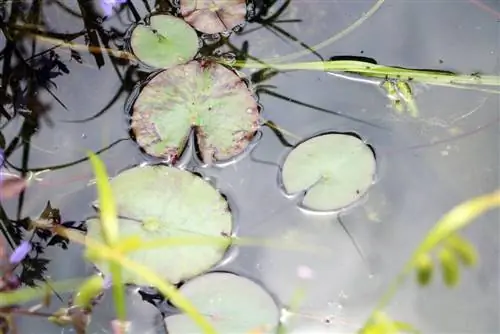
The safest long-term method of preventing green water in the garden pond is prevention. Since the algae need sufficient nutrients and light to reproduce, attention must be paid to the following factors:
- Do not place the pond under deciduous trees
- Direct sunlight ideally only for six hours a day
- Using a filter
- Use of large, strong aquatic plants
- Introduce floating aquatic plants as shade
- Remove fallen leaves and other coarse dirt with a landing net
- Feed fish sparingly
- Remove debris regularly
- Test water quality and adjust if necessary
- Create a pond capillary barrier
Cleaning
So that excessive amounts of nutrients cannot accumulate in the garden pond, the water must be cleaned accordingly. Various options and measures have already been mentioned for this purpose. Below:
- Landing net for coarse dirt
- Muscle vacuum cleaner or pond sludge remover for sludge
- Pond filter for finer suspended particles
The reduction of nutrients in the water not only ensures less algae growth, but also means that less sludge can accumulate. This in turn makes it easier to clean the garden pond more thoroughly.
Tip:
If a lot of leaves collect in the pond, stretching a close-meshed net over the water can reduce the cleaning effort.
UV light
Appropriate cleaning of the pond and filtering of the water can reduce the spread of floating algae and thus the formation of green water - but ordinary pond filters do not manage to remove the algae from the water themselves. This requires the targeted use of UV light. To achieve this, a so-called UVC pond clarifier or primary clarifier is required.
This destroys the algae and prevents it from spreading further. It also ensures that the floating algae clump together and can therefore be captured by the pond filter and removed from the water. When selecting the wattage, the following guide values apply:
- 1-2 watts per 1,000 liters of water without fish
- 2-3 watts per 1,000 liters of water with fish up to 1 kilogram
- 4-5 watts per 1,000 liters of water with fish up to 3 kilograms
Tip:
If there is already a UVC pre-clarifier and the pond water is still green, this could be due to a dirty cover or a UV lamp that is too old. We recommend changing the UV lamp annually and thoroughly cleaning the cover, especially in spring and summer, when the amount of algae is at its highest.
Chemical agents
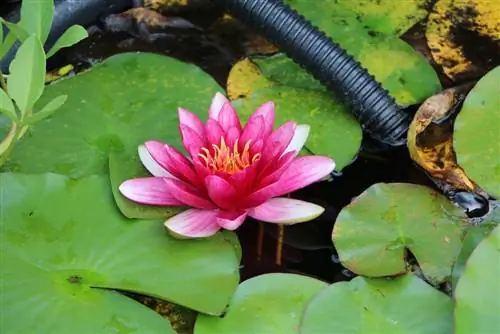
Algaecide agents are well suited as a short-term solution to reduce algae and when the pond is in full bloom, also as an additive to the cleaning by the primary clarifier and filter. The preparations are usually liquid and can be added directly to the garden pond. They interfere with the structure of the algae in such a way that they can no longer carry out photosynthesis. As a result, the floating algae lack important nutrients and they “starve”, so to speak.
When using algae control agents, make sure that they are not designed for long-term use in the pond. They only serve to destroy the algae in the short term, but if used repeatedly they can also have a detrimental effect on the water quality. In addition, if fish are present, it is necessary to pay attention to the compatibility of the product with aquatic life. Otherwise, the fish could be damaged or even die.
Aquatic plants
Aquatic plants offer two advantages in preventing and combating green water in the garden pond. Larger, faster-growing and stronger aquatic plants - such as waterweed or milfoil - remove nutrients from the water and thus become competition for the floating algae, which are deprived of an important basis for their spread. A balanced planted pond is already designed to prevent excessive proliferation of algae.
The second advantage can be found in large-leaved floating plants, such as water lilies or shell flowers. They provide shade for the water and therefore also reduce an important basis for algae proliferation. They also offer protection for the aquatic inhabitants from predators such as cats or birds. When planting, however, care must always be taken to ensure that the plants can also contribute to the nutrient enrichment of the garden pond through dead leaves or roots. So they do not replace regular cleaning of the water.
Silver carp
Silver carp are the ultimate killer of floating algae because they can filter the fine algae out of the water with their gills and consume them as food. However, the peaceful fish that get along well with goldfish sometimes become very large and heavy. Individual specimens reach a length of up to 130 centimeters and 60 kg. In the garden pond they usually remain significantly smaller, but there should still be several thousand liters of volume if the silver carp are to be kept. As a schooling fish, keeping at least four fish is species-appropriate.

